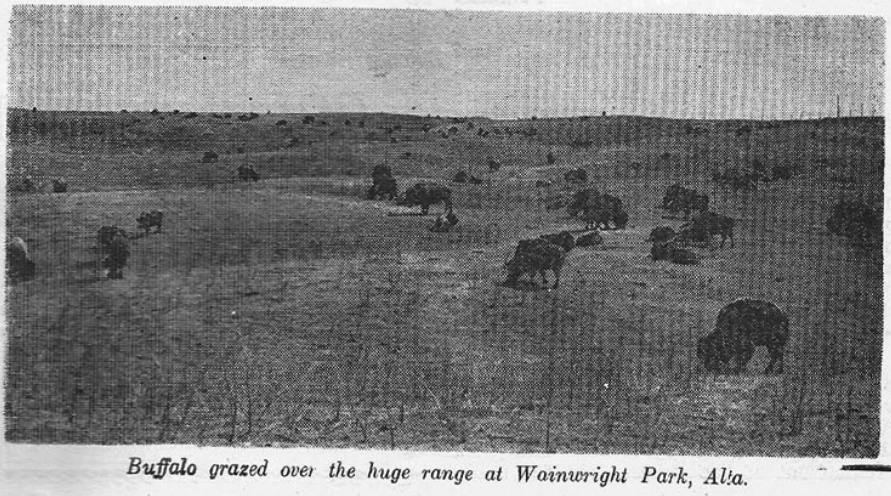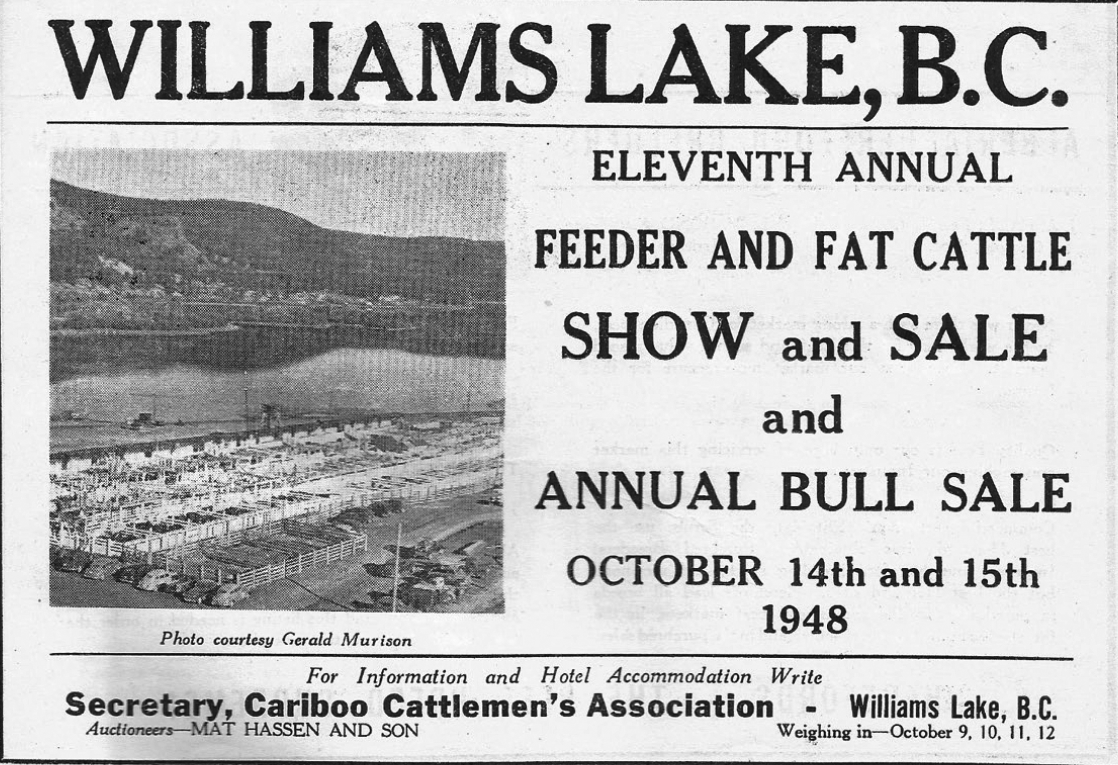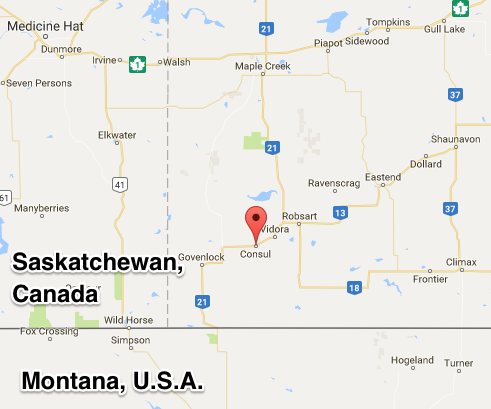Bone Pile Butte
By E.J. (Bud) COTTON, 2022 – 27th St. S.W. Calgary, Alta.
(Re-printed from “Canadian Cattleman”, September 1948, pgs. 57-61)
““BONE Pile Butte” situated in the old Buffalo Park at Wainwright, Alberta, just a few miles east of the Battle River, could tell stories of great buffalo herds and Indian hunters if it could only speak; of buffalo herds that roamed the Alberta Plains in the distant past and travelled down the long trail to be decimated by both red and white men until the noble animal was threatened with ultimate extinction. Then from 1909 to 1940, buffalo again trod the grass-grown trails and dug out the crumbling wallows of their forefathers. The Battle River Hills rumbled with the thunder of the mating bulls in mid-summer and the old Butte looked on and smiled as drumming hoofs and dust clouds once more tore through that long forgotten valley as the park riders trailed through with the buffalo on the annual round-up.
The Butte commands a view of miles of rolling plains and sand ridges. Nestled close in at its north base is a small circular valley bordered by willow and poplar scrub and entirely hidden from the view of the surrounding terrain. This is the site of what was apparently a very large annual Indian hunting camp. The fire stones of over sixty lodges or teepees were still visible a few years ago and near each
lodge was a mound of cracked marrow bones, somewhat scattered and grass- grown with the passing years and storms, but still quite distinct. It was from these bone piles that the Park riders gave the valley and Butte its name. Situated as it is in what was apparently the great annual circle of the vast herds of buffalo that roamed the plains in those long by-gone days, it was an ideal set-up for the Indian hunters. Scouts could see them drifting in from the lush meadows of Rib- stone Creek along the old trails that led across the plains close to the Butte and on down into the terraced hills and coulees that led down to the Battle River crossings and west over what is now the Saville Ranch holdings. For the relic hunter Bone Pile Valley should be a gold mine. The writer, while range riding in the Park, has found many old Indian souvenirs such as arrow heads, old trade knives and hatchet heads. One of the best was a crudely cut copper “double-headed eagle” brooch. I understand this double-headed eagle design belongs to the Navajo Indian tribe. What it was doing up in this northern clime is anybody’s guess.
Speaking of that old Bone Pile Butte, let’s hark back and in a condensed way follow through with buffalo history as close as possible; from the time when they ran free and unrestricted in their millions, through the years when they were
harried and slaughtered almost out of existence, to the day when they again came back to us and Canada once more has them ranging in the thousands on her plains. Though somewhat restricted as to range they are nevertheless protected and cared for by a paternal government and Canadians can proudly state that they now have the largest buffalo herd in the world.
The year 1521 found an adventurous Spaniard by the name of Hernando Cortes campaigning against the Aztec nation of Central America. He reported in his records of seeing great shaggy-headed, humped-backed beasts which were undoubtedly some of the ancestors of our buffalo.
Then again in 1530 a Spanish explorer by the name of Alvar Nunez Cabeza de Vaca, who was shipwrecked on American shores, decided on an expedition inland. In his travels which took him and his party into the territory now called Texas, he too, reported seeing herds of bison roaming the plains, a number of which they had killed in order to augment their meat supply.
In 1679 Father Hennepin, while on missionary work in the vicinity where Chicago now raises its stately buildings, tells of seeing large herds roaming in that sector.
D’Iberville makes mention in his historical writings of seeing herds of buffalo ranging in the vicinity of the present site of the City of New Orleans, in the year 1699.
In 1820 Sir John Franklin records seeing buffalo along the shores of the Great Slave Lake (2800 miles or more north of the southern buffalo ranges) during one of his exploring expeditions in that area.
The Journals kept by Alexander Henry in 1799, while at his “Red River Post”, report buffalo swarming the Red River Valley and west on the great plains. Even as late as 1810 large herds overran this section of the country. Quoting from his diary, written at his Post some thirty miles south of the International Border,—
“Sept. 18th, 1800—Immense herds of buffalo drifting slowly South.
Nov. 7th, 1801—Plains entirely covered with buffalo moving South.
June 14th, 1802—Country covered with buffalo drifting North.
June, 1803—Country from Park River to Riding Mountain crowded with buffalo herds.”
The last large herd of buffalo was seen in Manitoba by John Schott in 1861. That year he reports immense herds ranging in the Grand Valley and completely covering the present site of the city of Brandon.
In 1871, two eminent writers, Dr. J. A. Allan and Dr. W. T. Hornaday, in their works, estimated the buffalo at their peak had numbers around 50,000,000 and ranged over an area of approximately 1,500,000 square miles of plains from Texas north to Lake Athabaska.

As emigration from the continent increased and settlements were established the buffalo herds were pushed ever west and beyond the Allegheny Mountains.
With the advent of the railways into the new west, the general hunting of the buffalo for his hide and meat became organized and wholesale slaughter began in earnest. Both the Indian and white man, now equipped with firearms and horses, were urged on by the eastern traders’ demand for buffalo hides and vast as the buffalo herds had been it was not long before the harried herds began to show the effects of the wholesale destruction of their ranks. The half-breeds along the Red River were credited with killing about 36,000 annually. Hunters in droves swarmed the range and left rotting buffalo carcasses spread all over the prairies —feed for the wolves and coyotes. Around the hunting camps, hides lay staked out by the acre drying in the sun awaiting shipment to the Eastern markets. Greed for the buffalo hides seemed insatiable; large hides were in demand which meant that the large bulls and cows were shot down and the calves and younger animals were left to rustle for themselves in a hostile world that had gone berserk. Thousands starved or simply died in the mad man-made shambles and lay unskinned.
At the peak of the slaughter, which was reached between the years of 1872 and 1874, authentic records show that approximately three and a quarter million buffalo were slaughtered by the white hunters in what was called the Southern herd. When the Union Pacific Railway reached into the buffalo county in 1867 the great buffalo herd had been separated into what was called the North and the South herd.
The Northern herd, ever trailed and hunted on all sides by Indian and white hide and meat hunters, was soon doomed and over five and a half million buffalo went the way of the slaughtered Southern herd. In supplying the construction camps of the Northern Pacific Railway, “Buffalo Bill” Cody is claimed to have shot down well over 5,000 buffalo in less than two years.
On the Red River and south-west, well over five thousand white hunters and hide crews were cutting in on the ever-decreasing buffalo herd and the last big hunt of the Red River half-breeds is reported to have taken place during the year of 1880. By the time the Canadian Pacific Railway had strung its steel into the West, only a few buffalo and their grass-grown wallows and trails remained to tell of the once vast herds that had roamed the West.
There still was a herd reported numbering around 70,000 ranging about the Yellowstone River, scattered and ever hunted. Heading north, less than five thousand got as far as the international border.
These were quickly slaughtered with the exception of about a thousand head which had drifted over into the Dakotas. However, even this small fugitive herd was destined to die at the hands of the Indians of the western plains. A chief by the name of Sitting Bull and his tribesmen staged one last big buffalo hunt and by the time it was over not a single humped-back woollie was left. So outside of a few stragglers hiding out in the far places the buffalo had joined the limbo of the lost. The total extermination of the buffalo seemed an actual fact.
A few meager bunches lingered in the upper Saskatchewan for several years. One small herd of eleven head was reported by the Rev. J. A. McLaughlin as ranging in the Hand Hills during the summer of 1889; five of these were killed by Indian acquaintances.
The Come-Back
It was in 1877 that the Hon. James McKay of Fort Garry, Manitoba, started what should be termed the first attempt in Canada to conserve the just-about- vanished buffalo. Indian hunters brought in five buffalo calves (1 male, 4 females). These animals were acquired by Mr. McKay and ran loose on his estate and were protected and cared for. By 1882 the herd numbered 23 head. This Deer Lodge herd was purchased by Colonel Sam Bedson of Stony Mountain. Donald A . Smith (Lord Strathcona) was also interested in the herd. Later, part of the herd was sold to Buffalo Jones and shipped to Garden City, Kansas, again sold and added to the Pablo herd on the Flathead Reservation.
In the U.S.A. it was an Indian by the name of “Walking Coyote” who in 1874 conceived the idea of starting a buffalo herd of his: own. “Coyote” while on a hunting trip with some Peigan Indian friends captured four head of buffalo calves (2 males, 2 females) along the Milk River just south of the Border. He trailed these calves home to the Flathead Reservation and a new day for the buffalo had become a fact. As the years drifted by, the herd slowly increased and by 1884 “Walking Coyote” was the proud owner of 13 buffalo, but he was experiencing considerable difficulty in handling and financing his wards, so decided to try to sell out. Michel Pablo and Charles Allard, two prominent ranchers, decided to purchase and offered $250.00 per head. This offer was promptly taken up by “Walking Coyote”, who immediately hit for town and after a few short weeks of city life was found dead under the Missoula bridge. Thus passed away one of the founders of our present buffalo herds.
The herd was drifted overland to a new range at Ravalli where under the super- vision of Allard and Pablo, it increased rapidly. It should be mentioned here that the herd of Buffalo Jones of Kansas was also purchased and added to the Pablo herd. These animals were the ones that had been secured from Colonel Bedson of Manitoba some years previously. By 1896 the herd was estimated to number over 300. Another ten years passed and the buffalo running wild in the hills of the Flathead Reservation and along the Pen d’Oreille River grew fat on the lush pastures and their numbers increased. However, about this time Washington decided to open the Flathead Reservation to settlement and Pablo was forced to think of selling his woollie wards due to restricted range.
The U.S. Government was not interested. The Canadian Government was then approached and in 1907 a deal was made for the entire Pablo herd for them at Wainwright and Elk Island National Park, Lamont, Alta, The Montana Riders led by Charles Allard had their work cut out rounding up and loading the buffalo for shipment to Canada. The buffalo were wild and running in the Montana Bad Lands and along the ravines of the Pen d’Oreille River which made them a tough proposition to handle.
A total of 708 buffalo of the Pablo herd was unloaded in Alberta’s National Parks. The first two shipments to arrive, consisting of 77 head, were unloaded and turned loose in the Elk Island National Park, Lamont, Alta., as the Wainwright Park was not ready to receive shipments at that time. By the end of 1909 other shipments had followed and a total of 631 buffalo had been unloaded and were once more running loose on the range provided for them at Wainwright. To these were added 30 head secured from the Conrad Estate of Kalispel, Montana. Another bunch was brought in from the Banff National Park. This made a total of about 741 in the confines of the Wainwright National Buffalo Park.
With the mixing of these buffalo it had come to pass that the offspring of ”Walking Coyote’s” little band that he had picked up in 1873 near the Sweet Grass, and the orphan woollies that the Honorable “Jim” McKay of Winnipeg secured along the Battle River and raised on his Deer Lodge Estate, after years of separation and devious travels were able to say “HELLO BROTHER!!” once again, and travel down new trails on the Canadian plains.
So it was that old “BONE PILE BUTTE” once again saw buffalo ranging its grass-covered valley and trailing over the old trails and bone-piles of their ancestors.


